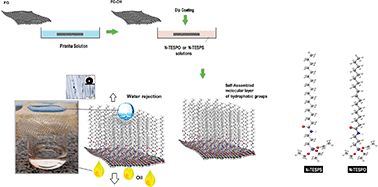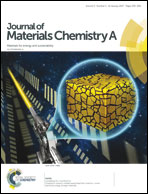Fabrication of robust and durable superhydrophobic fiberglass fabrics for oil–water separation based on self-assembly of novel N-TESPO and N-TESPS reagents†
Abstract
Novel robust and durable self-assembled fiberglass fabrics were prepared by immersing the OH-functionalized fiberglass fabrics into N-(3-triethoxysilylpropyl)oleamide (N-TESPO) and N-(3-triethoxysilylpropyl)stearamide (N-TESPS) reagent solutions. Results from scanning electron microscopy showed the rough surfaces with many interspaces and holes of the prepared self-assembled fiberglass fabrics. Results obtained from energy dispersive spectroscopy, X-ray photoelectron spectroscopy and Fourier-transform infrared spectroscopy analysis of the self-assembled fiberglass fabrics that were prepared revealed that the alkyl functional groups of N-TESPO and N-TESPS reagents were successfully formed on each fiberglass fabric. The contact angle results proved that the self-assembled N-TESPO fiberglass fabric was hydrophobic with a water contact angle (WCA) of 138.7°, while the self-assembled N-TESPS fiberglass fabric was superhydrophobic with a WCA of 154.8°. The durable fiberglass fabrics that were prepared could be applied for oil–water separation, with a separation efficiency of above 98%.


 Please wait while we load your content...
Please wait while we load your content...